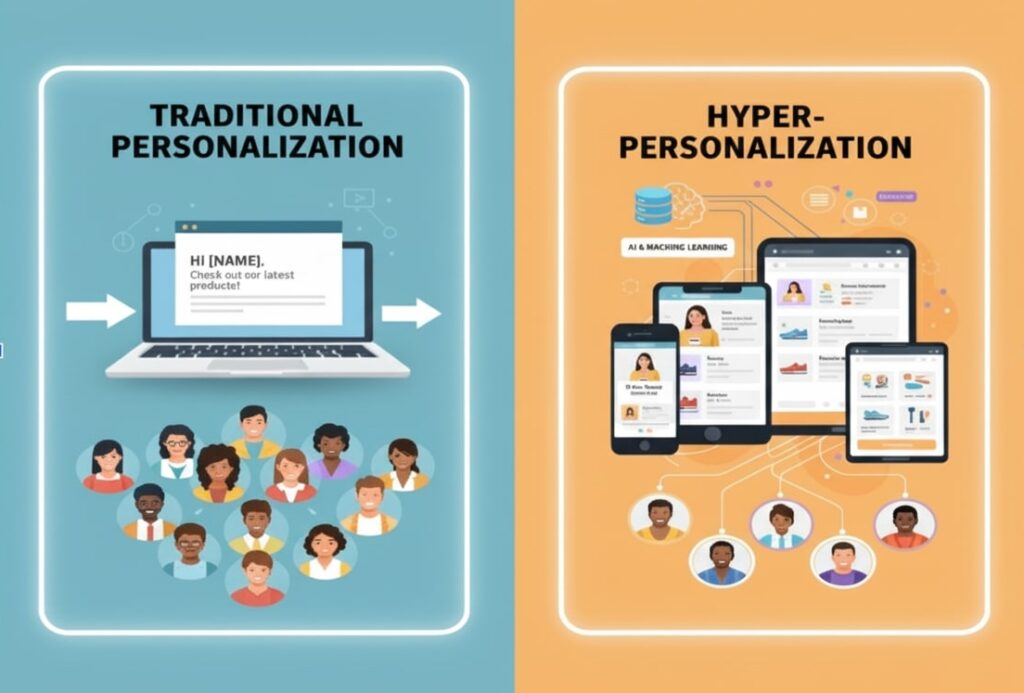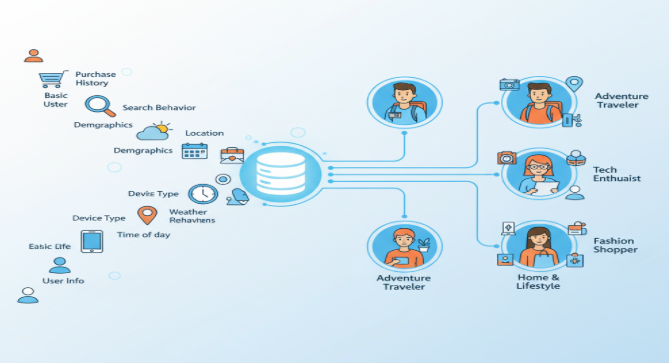The Rise of Hyper-Personalization: How to Connect with Your Audience on a Deeper Level

In today's crowded digital landscape, generic marketing messages simply don't cut it anymore. Consumers are bombarded with information, and their attention spans are shorter than ever. So, how do you cut through the noise and truly resonate with your audience? The answer lies in hyper-personalization.
What Exactly is Hyper-Personalization?
What Exactly is Hyper-Personalization?
Think of it as the next evolution of personalized marketing. While traditional personalization might address a customer by their name in an email, hyper-personalization goes much deeper. It involves using advanced data analytics, artificial intelligence (AI), and machine learning to predict customer behavior and deliver content, product recommendations, and offers that are uniquely suited to them
Why Does it Matter?
The benefits of hyper-personalization are undeniable:
- Increased Customer Engagement: When content is relevant, people are more likely to interact with it.
- Higher Conversion Rates: Tailored recommendations and offers lead to more purchases.
- Enhanced Customer Loyalty: When customers feel understood, they develop a stronger connection with your brand.
- Improved ROI: By targeting more effectively, your marketing spend goes further.
The Pillars of a Successful Hyper-Personalization Strategy
Implementing hyper-personalization isn't just about flipping a switch; it requires a strategic approach built on several key pillars:

1. Robust Data Collection & Segmentation
The foundation of hyper-personalization is data.
To truly understand your audience, you need a 360° view of who they are and how they behave.
This includes:
Demographics: Age, gender, location, and income level.
Behavioral Data: Website activity, browsing time, purchase frequency, and email engagement.
Psychographics: Interests, values, and motivations inferred from behavior.
Real-time Contextual Data: Device type, current location, time of day, and even weather conditions.
Once collected, this data must be organized into actionable segments. The goal isn’t just to gather information — it’s to turn it into insights that help deliver the right message at the right time.
2. Predictive Analytics & AI Integration
The real magic of hyper-personalization lies in prediction.
Using AI and machine learning, brands can anticipate what customers are likely to do next.
For instance, Netflix uses algorithms to recommend shows you’ll probably enjoy based on your watch history. Similarly, e-commerce platforms can suggest products before you even start searching for them.
By predicting needs rather than reacting to them, businesses can create a smoother and more intuitive experience that feels effortless for the customer.
3. Dynamic Content Delivery
Static campaigns are a thing of the past.
Hyper-personalization thrives on dynamic content — adapting messaging, visuals, and offers based on real-time context.
Imagine visiting a brand’s website and seeing a homepage banner featuring the exact product you viewed on Instagram earlier that day. Or receiving an email with a discount on an item you’ve had sitting in your cart.
This kind of dynamic experience keeps the interaction seamless and personal.
4. Omnichannel Consistency
Your customers don’t interact with you on one platform — they move between Instagram, email, your website, and sometimes even in-store.
A successful hyper-personalization strategy ensures a unified experience across all touchpoints.
That means recognizing the same user whether they’re browsing on desktop or mobile, and tailoring content accordingly. Consistency builds trust, and trust drives long-term engagement.
5. Ethical Data Usage & Transparency
As personalization becomes more advanced, privacy and trust are more important than ever.
Consumers are increasingly aware of how their data is being used — and they expect transparency.
Always ensure compliance with data protection laws (like GDPR) and clearly communicate how customer data benefits them.
When customers trust that their data is being used responsibly to improve their experience, they’re more likely to engage.
Looking Ahead: The Future of Hyper-Personalization
In the next few years, hyper-personalization will only get smarter.
With AI becoming more sophisticated and real-time data more accessible, brands will move toward emotion-driven personalization — where marketing adapts not just to who someone is, but how they feel in that moment.
Voice search, wearable devices, and augmented reality (AR) experiences will also feed into this, creating deeply immersive, individualized brand journeys.
Final Thoughts
Hyper-personalization isn’t a marketing trend — it’s the new standard.
In a world where consumers expect relevance, speed, and authenticity, brands that fail to personalize will fade into the background.
But those that master hyper-personalization will unlock stronger connections, deeper loyalty, and exponential growth.
Author: Mohammed Uzaif
Digital Marketing Strategist In Ksaragod | Exploring the Future of Personalized Experiences